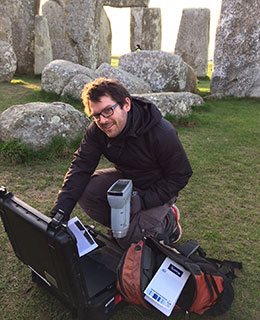Thanks to Philip for alerting me to this. In Andy Burnham's new book, on page 94, there is a statement to the effect that "petrographic analysis of some of the sarsen stone at Stonehenge has shown that it was brought west from Kent."
If true, this would of course be of immense interest. The only work currently going on in the field of sarsen study is the project at the University of Brighton, which I flagged up earlier this year:
https://brian-mountainman.blogspot.com/2018/05/geochemical-fingerprinting-of.html
The key researchers are Professor David Nash and Dr Jake Ciborowski, and Tim Darvill and Mike Parker Pearson have assisted in the provision of samples from assorted digs.
Here is the project description:
The sources of the stone used to construct Stonehenge have been debated by archaeologists and geologists for over a century. The smaller Bluestones, derived from west Wales, have attracted most attention. In comparison, virtually no work has been done on the sources of the larger sarsen stones (silcretes) used to construct the central Trilithon Horseshoe, outer Circle and peripheral settings. Conventional wisdom suggests that, given their size, the sarsens were all sourced from the Marlborough Downs. However, petrological, mineralogical and laser-scanning analyses indicate considerable variability among the Stonehenge sarsens, making this assumption questionable.
The most accurate means of determining the provenance of any stone artefact is geochemical fingerprinting, whereby the elemental chemistry of the artefact is matched against that of potential source areas. For Stonehenge, this would require two stages: an initial analysis of the sarsen stones at the monument,followed by equivalent analyses of sarsen boulders across their range of natural occurrence (i.e. south of a line from Devon to Suffolk).
This project, funded by British Academy/Leverhulme Small Research Grant SG170610, aims to address the first of these stages.
Project timeframe
This project commenced in October 2017 and will end in March 2019.
Project aims
The primary aim of this project is to determine, for the first time, the chemical variability of the sarsen stones at Stonehenge. This will allow us to assess whether, as appears likely from laser scanning data, there are stones with differing chemistries (and hence potentially different sources) at the monument.
Our second aim is to undertake pilot chemical analyses of sarsen boulders from selected areas of southern England, including clusters close to Stonehenge (Salisbury Plain, Marlborough Downs) and more distant (e.g. Hants, Sussex, Kent, Suffolk). This will allow us to scope, for the first time, the chemical variability in natural sarsen occurrences, and more efficiently target areas for intensive investigation in the future.
To avoid the need to core at the monument, we plan to analyse samples from two collections of sarsen fragments from Stonehenge. These derive from two sets of excavations in 2008 (led by project partners Tim Darvill and Mike Parker-Pearson) and represent a selection of sarsens from the monument. The first, between the sarsen Circle and Trilithon Horseshoe, uncovered sarsen debris from stone-breaking, possibly used as packing materials. The second, to the north of Stonehenge, revealed extensive working debris from two areas where sarsens were dressed prior to erection.
We will analyse each sarsen fragment in these collections using non-invasive pXRF, to identify broad chemical groupings. Based on this, we will select 100 samples from across these groups for combined ICP-MS and ICP-AES analyses. A similar approach will be used to select 40 samples for pilot analysis from the extensive collection of sarsens from southern England held at the University of Brighton. ICP-MS/AES data will be assessed using standard geochemical provenancing approaches to define any chemical groups within the Stonehenge samples, and provisionally match these groups against source areas. Following these analyses we will select samples for further investigation, including via a novel combination of petrological, cathodoluminescence and Qemscan analyses of polished thin-sections, to crosscheck any potential geochemical match.
Project findings and impact
The project is in progress, with a completion date of March 2019. Key results and links to publications will be added here as the project progresses.
====================
So far as we know, there have not as yet been any publications. Will try to find out more.
PS. False alarm! Andy has somehow got this wrong. Prof David Nash assures me that they have never made this claim. Sampling and analysis is still going on -- the work will be published next March, all being well.
PS. False alarm! Andy has somehow got this wrong. Prof David Nash assures me that they have never made this claim. Sampling and analysis is still going on -- the work will be published next March, all being well.

2 comments:
Mike Pitts talked about the need for this a vis Stonehenge's sarsens' provenances on Digging Deeper in late Spring 2018 at the end of an item on Greater Stonehenge landscape research.
People should look at David Field and David McOmish's "Neolithic Horizons" (2016), page 99 in the Chapter 'Landscape with Stones....... e.g. Flinders Petrie speculated an origin in the immediate vicinity.Gowland, and Geologists Judd and HH Thomas came to similar conclusions. Rev E Duke in 1846 and subsequently E.H. Stone both considered that the sarsen in the N E arc may have come froma local buried seam,since all were relatively flat and of tabular form. The Book's Authors state that a number of potenbtial swallow - holes survive on the downs close to the stone settings - one such massive feature exists just to the S W, and other depressions that may have contained stones occur on the slopes to the N E.
Post a Comment